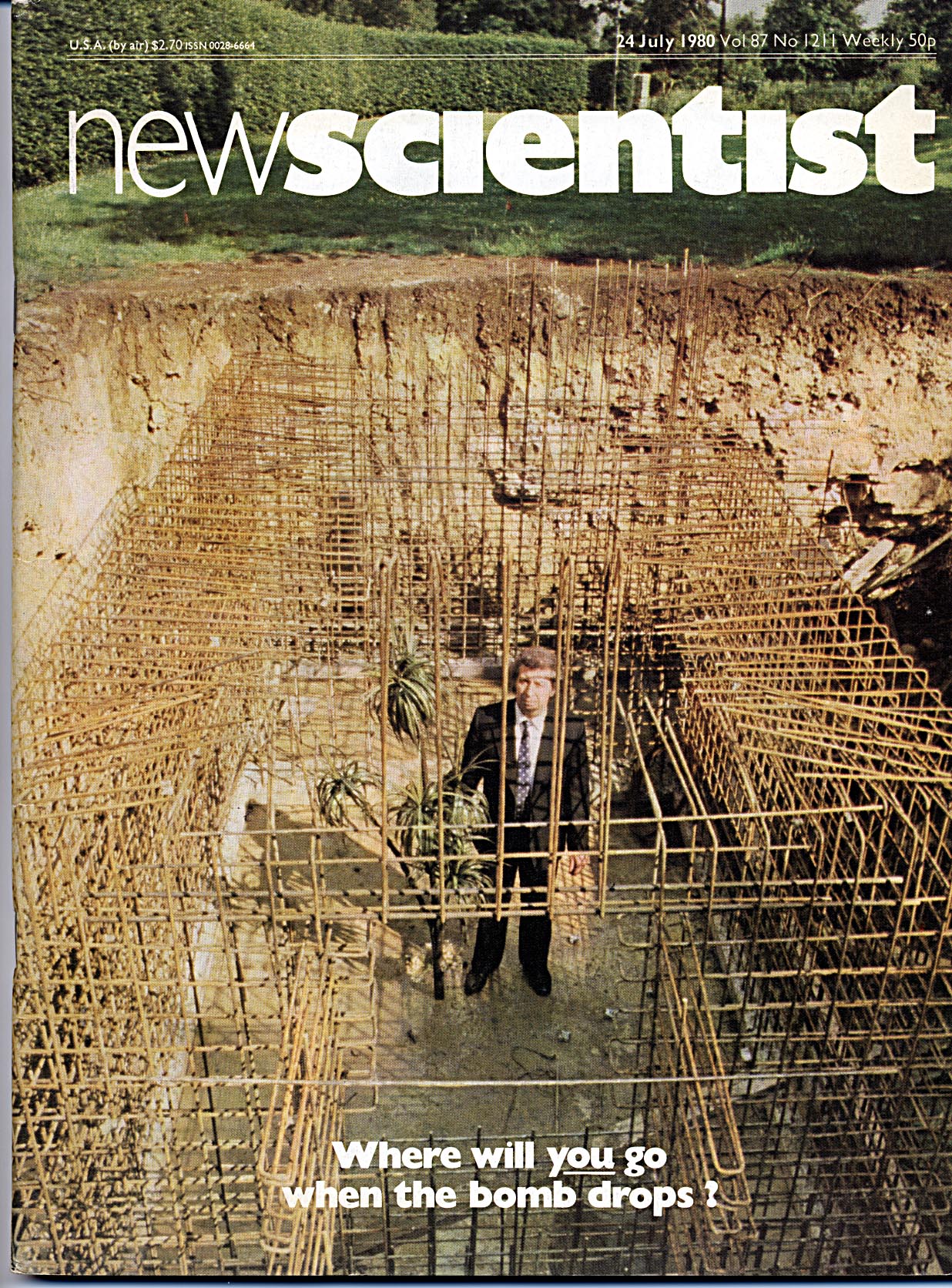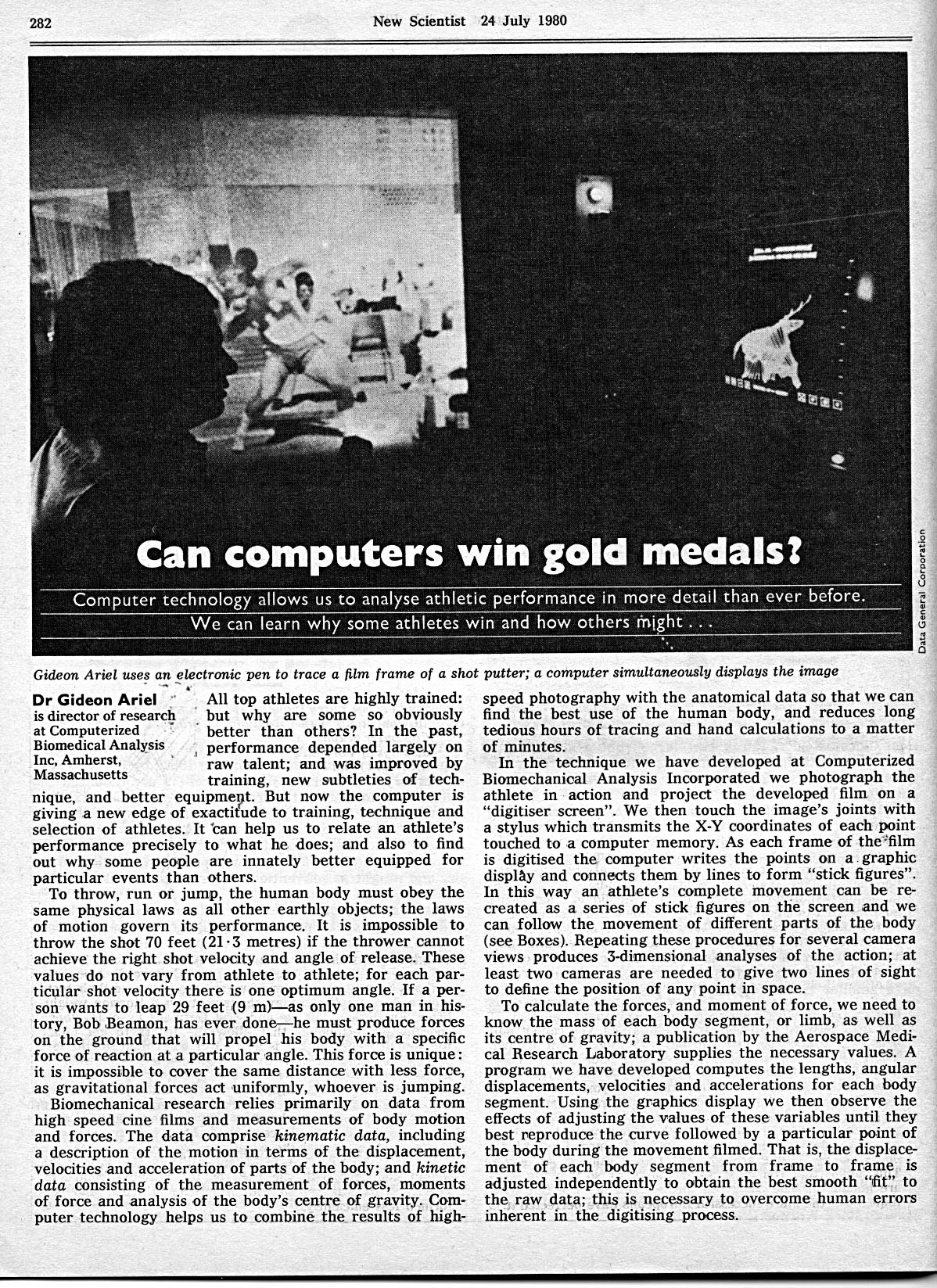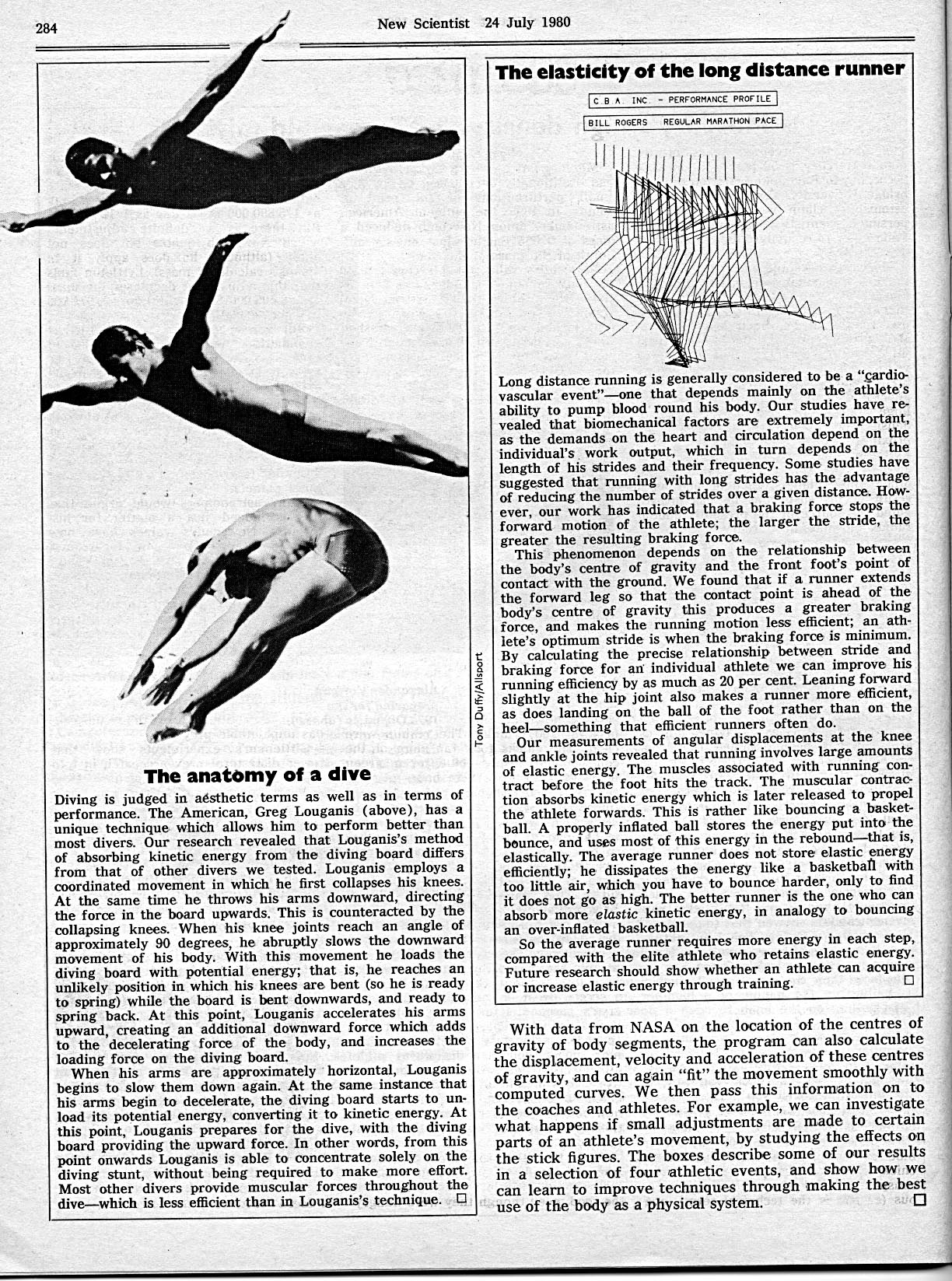Can computers win gold medals?
Computer_ technology allows us to analyse athletic performance in more detail than ever
By Unknown in New Scientist on Tuesday, July 1, 1980
The article discusses how computer technology is being used to analyze athletic performance in detail. Dr. Gideon Ariel, director of research at Computerized Biomedical Analysis Inc, uses an electronic pen to trace a frame of a shot putter, with a computer simultaneously displaying the image. The computer helps to relate an athlete's performance precisely to what they do, and also to find out why some people are better equipped for particular events than others. The data from high-speed films and measurements of body motion and forces are used to create "stick figures" that recreate an athlete's complete movement. This technology is used to improve techniques in various athletic events, including hammer throwing, weightlifting, diving, and long-distance running.
Tip: use the left and right arrow keys
282
New Scientist 24 July 1980
Can computers, win: gold medals?
Computer_ technology,, allows us, to analyse athletic, performance in more detail than ever. before.
We can; learn why some athletes win and how others -fnight'.
Gideon Ariel uses an electronic pen to trace a him frame of a shot putter; a computer simultaneously displays the image
Dr Gideon Ariel All top athletes are highly trained: is director of research but why are some so obviously at Computerized - better than others? In the past, Biomedical Analysis performance depended largely on Inc, Amherst, raw talent; and was improved by Massachusetts training, new subtleties of tech
nique, and better equipment. But now the computer is giving a new edge of exactitude to training, technique and selection of athletes. It 'can help us to relate an athlete's performance precisely to what he does; and also to find out why some people are innately better equipped for particular events than others.
To throw, run or jump, the human body must obey the same physical laws as all other earthly objects; the laws of motion govern its performance. It is impossible to throw the shot 70 feet (21.3 metres) if the thrower cannot achieve the right shot velocity and angle of release. These values do not vary from athlete to athlete; for each particular shot velocity there is one optimum angle. If a person wants to leap 29 feet (9 m)-as only one man in history, Bob Beamon, has ever done-he must produce forces on the ground that will propel his body with a specific force of reaction at a particular angle. This force is unique: it is impossible to cover the same distance with less force, as gravitational forces act uniformly, whoever is jumping.
Biomechanical research relies primarily on data from high speed cine films and measurements of body motion and forces. The data comprise kinematic data, including a description of the motion in terms of the displacement, velocities and acceleration of parts of the body; and kinetic data consisting of the measurement of forces, moments of force and analysis of the body's centre of gravity. Computer technology helps us to combine the results of high
speed photography with the anatomical data so that we can find the best use of the human body, and reduces long tedious hours of tracing and hand calculations to a matter of minutes.
In the technique we have developed at Computerized Biomechanieal Analysis Incorporated we photograph the athlete in action and project the developed film on a "digitiser screen". We then touch the image's joints with a stylus which transmits the X-Y coordinates of each point touched to a computer memory. As each frame of the 'film is digitised the computer writes the points on a graphic display and connects them by lines to form "stick figures". In this way an athlete's complete movement can be recreated as a series of stick figures on the screen and we can follow the movement of different parts of the body (see Boxes). Repeating these procedures for several camera views produces 3-dimensional analyses of the action; at least two cameras are needed to give two lines of sight to define the position of any point in space.
To calculate the forces, and moment of force, we need to know the mass of each body segment, or limb, as well as its centre of gravity; a publication by the Aerospace Medical Research Laboratory supplies the necessary values. A program we have developed computes the lengths, angular displacements, velocities and accelerations for each body segment. Using the graphics display we then observe the effects of adjusting the values of these variables until they best reproduce the curve followed by a particular point of the body during the movement filmed. That is, the displacement of each body segment from frame to frame is adjusted independently to obtain the best smooth "fit" to the raw data; this is necessary to overcome human errors inherent in the digitising process.
New Scientist 24 July 1980
283
Men with big muscles
�+Ih
4% 11 .�-'
zowl
.'M ~:�*1I
Jolla.,
11'!r'.::uufl slINIV:4117
- <1a{~~i1t11>
."A Zd
"
1 i
r v .rt
. , r
'.!I\I1t1tf111I1,r tii ~ ~ ~~si~l'
ii .i;; *$ :1111riti*r~Ir'i- rl-will'
1~ !!a!iwi\1111{111ttii`aijiilit I,'!:r!~ 1� 1\1\t\\Ag;iIi i $l
1
sib Z ~~we %Wft*1hN,U1r, ~"
11~t\g11I-~~L - %6 oft
.060
Rr, `~\11r fir;-t 1
%a1{liiiii ti`s i M -,11L maw Vaptt jnl, �1tlt !v �~~~
s1�1t 1f �'-~ v.==.!
IL Ia.,
1111 'Ill/ /Itr' .Q:;�:irG
_' Irrr><~~intr>
Yuri Sedyh took the gold medal for hammer throwing at the 1976 Olympics in Montreal
At one time, American throwers dominated most field events, including the hammer throw. In recent years, however, Americans have not been able to throw the hammer as far as athletes from the USSR and the Eastern bloc countries. At the Montreal Olympic Games, no American threw the hammer further than the qualifying standard of 226 feet (68.8 metres), although 25 Soviet athletes did so. That year's gold medal winner was Yuri Sedyh, shown in action above.
Our analysis showed that the shorter throws of the American athletes were paralleled by relatively low velocities during the turns, with correspondingly low linear velocities of the hammer. These velocities were low because the Americans displaced their centres of gravity inefficiently.
Pulling on the handle of a hammer, to accelerate it, is like pulling on the knob to open a door that's jammed. If you lean forward with your feet behind you, you cannot pull back on the knob because you have nothing to pull against. You have to place your feet between your body and the doorknob and push against your feet. If you keep your legs straight as you lean back, you have only your body weight to pull with, but if you bend your legs first you can then push with your leg muscles as you try to straighten them, producing a force greater than your body weight. Another important point is that you can apply the most force to the doorknob by pulling straight out rather than at an angle. This means that you must lower your body so that the arms are horizontal. The American throwers do not use this technique-but the more successful Europeans have perfected it. 0
POSITION 26 -- SEGMENT DO
Weightlifting was once an event of American glory, but the US has now lost its prowess to the Eastern Europeansperhaps because the recent winners have improved their techniques. The graphic display above portrays a Russian weightlifter. Bulgarians, Soviets and East Germans have developed coordinated techniques that allow the lifters to get under the weight when the bar is at a lower point than for the less successful athletes; but the Europeans are still able to accelerate the bar upward from the lower position. Our studies indicate that weightlifters in the US delayed getting under the bar until the bar had begun accelerating downward. They could not therefore lift greater loads because once the weight was descending, a lifter had to overcome the inertial forces and the weight of the bar.
We also observed that, in European lifters, the path of the weight coincides with the path of the athlete's centre of gravity. This was not so with American athletes, who performed less efficiently. 0
C B A INC - PERFORMANCE PROFILE
fVORONIN 110 KG
Alexander Voronin, preparing for the
1976 Olympics (above). Computer graphic displays of Voronin's lift (right) and of other East European lifters, showed why these athletes perform more efficiently than their American-counterparts
284 1/ New Scientist 24 July 1980
The elasticity of the long distance runner
IC B A INC - PERFORMANCE PROFILE BILL ROGERS REGULAR MARATHON P'CE
The anatomy of a dive
Diving is judged in adsthetic terms as well as in terms of performance. The American, Greg Louganis (above), has a unique technique which allows him to perform better than most divers. Our research revealed that Louganis's method of absorbing kinetic energy from the diving board differs from that of other divers we tested. Louganis employs a coordinated movement in which he first collapses his knees. At the same time he throws his arms downward, directing the force in the board upwards. This is counteracted by the collapsing knees. When his knee joints reach an angle of approximately 90 degrees, he abruptly slows the downward movement of his body. With this movement he loads the diving board with potential energy; that is, he reaches an unlikely position in which his knees are bent (so he is ready to spring) while the board is bent downwards, and ready to spring back. At this point, Louganis accelerates his arms upward, creating an additional downward force which adds to the decelerating force of the body, and increases the loading force on the diving board.
When his arms are approximately horizontal, Louganis begins to slow them down again. At the same instance that his arms begin to decelerate, the diving board starts to unload its potential energy, converting it to kinetic energy. At this point, Louganis prepares for the dive, with the diving board providing the upward force. In other words, from this point onwards Louganis is able to concentrate solely on the diving stunt, without being required to make more effort. Most other divers provide muscular forces throughout the dive-which is less efficient than in Louganis's technique. 0
c
Long distance running is generally considered to be a ".gardiovascular event"-one that depends mainly on the athlete's ability to pump blood round his body. Our studies have revealed that biomechanical factors are extremely important, as the demands on the heart and circulation depend on the individual's work output, which in turn depends on the length of his strides and their frequency. Some studies have suggested that running with long strides has the advantage of reducing the number of strides over a given distance. However, our work has indicated that a braking force stops the forward motion of the athlete; the larger the stride, the greater the resulting braking force.
This phenomenon depends on the relationship between the body's centre of gravity and the front foot's point of contact with the ground. We found that if a runner extends the forward leg so that the contact point is ahead of the body's centre of gravity this produces a greater braking force, and makes the running motion less efficient; an athlete's optimum stride is when the braking force is minimum. By calculating the precise relationship between stride and braking force for an individual athlete we can improve his running efficiency by as much as 20 per cent. Leaning forward slightly at the hip joint also makes a runner more efficient, as does landing on the ball of the foot rather than on the heel-something that efficient runners often do.
Our measurements of angular displacements at the knee and ankle joints revealed that running involves large amounts of elastic energy. The muscles associated with running contract before the foot hits the track. The muscular contraction absorbs kinetic energy which is later released to propel the athlete forwards. This is rather like bouncing a basketball. A properly inflated ball stores the energy put into the bounce, and uses most of this energy in the rebound-that is, elastically. The average runner does not store elastic energy efficiently; he dissipates the energy like a basketball with too little air, which you have to bounce harder, only to find it does not go as high. The better runner is the one who can absorb more elastic kinetic energy, in analogy to bouncing an over-inflated basketball.
So the average runner requires more energy in each step, compared with the elite athlete who retains elastic energy. Future research should show whether an athlete can acquire or increase elastic energy through training. 0
With data from NASA on the location of the centres of gravity of body segments, the program can also calculate the displacement, velocity and acceleration of these centres of gravity, and can again "fit" the movement smoothly with computed curves. We then pass this information on to the coaches and athletes. For example, we can investigate what happens if small adjustments are made to certain parts of an athlete's movement, by studying the effects on the stick figures. The boxes describe some of our results in a selection of four athletic events, and show how we can learn to improve techniques through making the best use of the body as a physical system. 0




